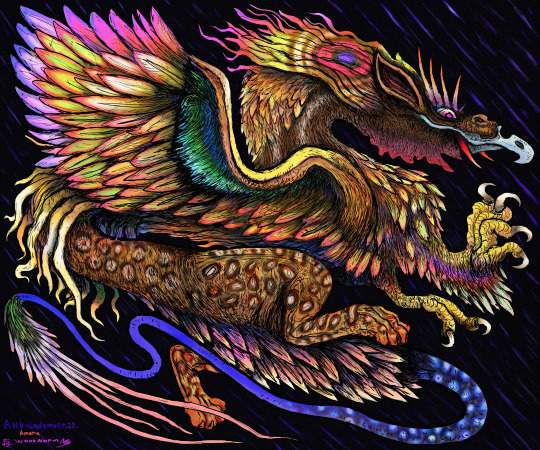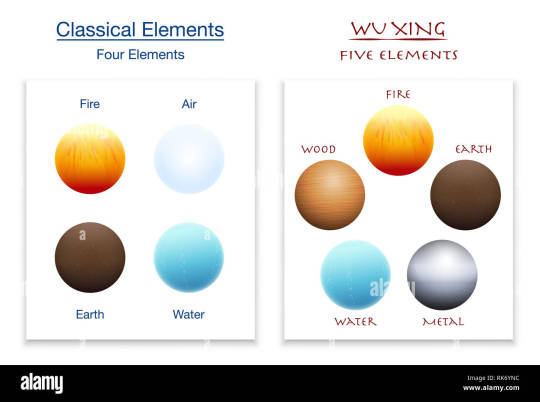#South American Mythology
Text
Mythology open request
Summary: Very few are against the gods, many are the charlatans who claim to deny their existence (to live outside their yoke). The godslayers are not born from abandoning their faith, but from having met their creators. Even with the pain in his heart, with all the lives and deaths he suffered, the godslayer would raise his sword for that soul he swore to protect.
A little bit of lore to make the mythology asks. See the tags to know what mythologies I do (Sorry for the masive tags).

The boy of many names ran with the soul of that person he swore to protect, of that person who promised him that no god would play with his destiny and of that person who promised himself that he would not end up like Agnes.
--- I promise that, whatever it takes, no one will harm you. I will give you your freedom --- whispered to the soul, which approached the lips of the young man as a sign of a kiss --- No matter the deaths and lives, I promise to give you moments of joy and freedom.
--- Argenis --- whispered the soul --- Thank you.
Asier looked at his nanny as in past lives he had seen her before: A friend, a sister, a lover, a confidant… a person to protect.
He knew that Hades had already had his eye on the young woman, it was not difficult to identify: in his first life, his first name and prophesied curse: Argenis, had spent time with the once called uncle. He knew the traces left by the gods, this one in particular was that of Hades.
Asier, even with his child's body, would protect the girl from the madness that the god of the dead was committing. Didn't he realize that he was condemning his beloved? Persephone would be so cruel to the poor girl that Minthe would seem like a wise mercy.
Worst of all, Asier suspected that more gods had taken notice of the human. The boy knew that he would not be able to take them all on, that it would result in his death.
But an oath, a promise and his word had to be kept, that was what he had been taught by his parents in the past: Ares, Athena, Lugh, Urd, Ibejis and many more.
And he hoped not to face them, to avoid the pain it would cause in his spirit and heart.
--- Asier, did your father buy me a sack of rice? --- asked the nanny looking at the sack with her name on a little card. The boy gave a sigh and shook his head, pushing the woman away from the sack. He thought he still had time to get rid of it, but he was so busy burning the black tiger that he forgot about the sack of rice.
--- No, maybe it's something he' s going to donate to the trough.
--- Ugh, thank goodness, I was already scared.
Asier was happy for her, but he was the one who was now more terrified and worried.
#yandere#greek mythology x reader#Egyptian mythology x reader#celtic mythology x reader#Greek Mythology#Norse Mythology#Egyptian Mythology#Celtic Mythology#African Mythology#Mesopotamian Mythology#Hindu Mythology#Slavic Mythology#Chinese Mythology#Japanese Mythology#Polynesian Mythology#North American Mythology#Mesoamerican Mythology#South American Mythology#Abrahamic Mythology#Arthurian Legends
57 notes
·
View notes
Text


Mythology Weekend - Naiá
The origin story of the Vitória Régia, or the giant water lily, was passed down by the indigenous Tupi-Guarani people of South America, particularly in Brazilian mythology. It is said that the moon goddess Jaci would choose her favorite young women in the village and turn them into bright, shining stars. A young girl named Naiá dreamed of becoming a star, although she would no longer be human, and desperately roamed the mountains seeking the moon. Seeing it's reflect in the water of a clear lake, she dove in to reach it and drowned. For Naiá's sacrifice, the goddess turned her into "the star of the waters", or the giant water lily.
#my post#capsule wardrobe#capsule#fashion#style#minimalism#minimalist wardrobe#minimalist fashion#white#green#brown#summer#mythology#mythology weekend#south american mythology#Tupi-Guarani#brazilian mythology#Naiá#it doesn't seem like a super popular myth but I liked it :)#I wanted to go more traditional but I couldn't find good reference pictures so I went with specifically Brazilian designers
10 notes
·
View notes
Text

"La Reina"
by J.D. Yanez
“No one will believe us. We’re just four kids from the projects, doomed to repeat cycles they gave us..."
J.D. Yanez

J.D. Yanez's debut novel, "La Reina" tells the story of Raina Medina's return home after a 10 years absence. Her hometown is nearly the same as she left it, but now something sinister is aiming to keep her there. Something as evil as the secret that sent her running. With the three friends she left behind, Raina hopes to bury this evil before it buries her. Because, this time, there's nowhere else to run.
Raina Medina is no Mary Sue. She has a strength about her even in her weakest moments. But she has also been shaped by cruelty and raised by madness. This novel is as much about identity as it is about the monster lurking in her shadow.
I have always adored mysteries and loved thrillers, but I always managed to predict the ending. I spent too many years studying film structure to be surprised. However, absolutely nothing could have prepared me for the soul-crushing realizations that Yanez had in store.
Highly anticipated, this book is well-worth the 5 star rating. The pacing, the characters, the structure of this story is something I haven't seen in a long time. Even the plot-twists are bound to keep you up at night. This story haunts me, and I'm sure "La Reina" will haunt you too. It offers you something new through every read-through: a clue, a different perspective, another answer.
So, if you're looking for a thriller with a twist or want an original gothic horror that showcases South American mythology and culture, "La Reina" is the novel for you. Yanez is brilliant, and I eagerly await the day for her next release. For now, I have a Medina short story to read.

Title: "La Reina"
Author: J.D. Yanez
Genre: Gothic Horror, Thriller
Release: 1 Apr 2024
Warning: Mature Content
#book review#sonderous reads#book recommendations#bookblr#dark aesthetic#gothic#gothic literature#south american mythology#thriller
0 notes
Text










South of Midnight, a third-person action adventure set in an original world of magic, monsters and giant, blues-playing skeletons. The game's debut trailer is a cinematic snippet introducing the protagonist, a young woman named Hazel, as she attempts to reason with an immortal specter on a dark dock. Hazel is hunting a monster — or, it's hunting her, as the trailer goes on to show — and she can wield bright threads of magic.
#South of Midnight#video game#Black American folklore#folklore#Gothic#Black goth#mythology#Hazel#Black character#Black characters#Southern culture#Black folklore#Shakin' Bones#Black American culture#magic#weaving#this looks freakin’ amazing!!#Black mythology
821 notes
·
View notes
Text

The Amaru or Katari (Aymara) a majestic twin headed serpent like creature depicted across Andean Civilizations, Originally said to have been capable of transcending spiritual and otherworldly boundaries for the world was Separated into the realm of the gods and birds, Hanan Pacha or the world above; the world where mankind resides the Kay Pacha or world of the present; and finally the underground realm of the dead or the Ukhu Pacha, the world below. where its said the Amaru would move the world by its shear size and force of will, creating many of the mountainous outcroppings seen in the region, or creating devastating earthquakes. This would gain the great beasts the ire of the of gods and leading to cataclysmic and deadly conflict's the great serpents deaths would create vast mountain ranges.
The revered creatures lore and depictions would be altered to suit changing society's and foreign colonial influence trying and suppress Indigenous beliefs and values, some Incan rulers even tried to harness this power by adopting name for themselves to try and cement their political gain . Eventually this lead to depictions that suited a more chimeric monstrous for, reflecting its old world counter parts, adopting traits from many other creature, to now be defeated by mere humans.
some cultures preserved and even re incorporated these new aspects with the old, creating hybrid depictions and gaining very broad symbolism such as the economy of water, and tending to the land, and even more cosmological aspects of space or wisdom, or simple fundamentals of the creativity of the peoples, sometimes these new Amaru could be seen clashing with each other. representing the more destructive side of nature, devastating the peoples and the lands, too only be stopped by the storms themselves or through the intervention of their old rivals, now taking a new cast of god's. once again through death creating the Mantaro valley returning to their earthly roots.

#amaru#dragon#serpent#creaturedesign#digital art#monster#inca empire#Andean civilization#mythology#south american#chimera#illustration
40 notes
·
View notes
Text
every time dokja is surprised about yoo joonghyuk knowing about greek mythology i laugh because like. idk i kinda just assumed everyone had a greek mythology phase at some point in their lives. i was wrong of course but i do now have the mental image of a middle schooler yjh poring over percy jackson books

#omniscient reader's viewpoint#orv spoilers#i dont know if greek mythology is taught in south korea#so i can only speak from experience as an american#but like there’s a mental image in my head of a young yjh reading greek myths and stuff#but also like#dokja being like ‘no way how does he know that’ but like in my head im like ‘no way how does he not know that’#no offense to anyone who didnt have a greek mythology phase#also im aware he definitely learned this info from past regressions#but still. still still i am going to hold that mental image in my heart#for my mental health
15 notes
·
View notes
Text
youtube
Campina Grande, Brazil-based gothic rock act Noturna Régia performing the song "Medusa" from their 2019 album Sobre Anjos e Outros Contos
#gothic rock#gothcore#goth men#nu goth#Noturna Régia#Medusa#Sobre Anjos e Outros Contos#music#Brazilian#South American#Campina Grande Brazil#2019#Noturna Regia#rock em português#goth em português#Greek mythology#gorgon#Youtube
3 notes
·
View notes
Text

THIS IS NOT A DRILL. I'MMA NEED EVERYONE TO PUT ALL THEIR WISHES AND SPELLS AND PRAYERS AND WHAT NOT THAT WE GET HINDU PANTHEON PLEASE FOR THE LOVE OF ALL THAT IS WAS AND WILL BE HOLY AND/OR UNHOLY.
PLEASE 😩😩😩🤌🏽🤌🏽🙏🏽🙏🏽🙏🏽🙏🏽🤞🏼🤞🏼🤞🏼🤞🏼
#dislyte#y'all don't understand#i NEEED this#nezha is the closest we got and i NEEED MORE#also i have a headcannon that li ling's mum is south indian and an esper of the Hindu Pantheon (Durga/Kali)#I WOULD CRY TEARS OF JOY IF THEY WERE TO JOIN#but I'd also be down for any indigenous mythology#like ANY#would also be cool if we got some american mythologoy/legends#just because it would be hilarious if someone was the esper of like johnny appleseed or paul bunyan 🤣🤣
56 notes
·
View notes
Text

The Amazon Rainforest is one of the most beautiful and unique places in the world, easily comparable to a mythical world!🇧🇷
🏹🐊
🐆🏺
#history#amazon rainforest#amazon river#brasil#pira-tapuya#south american history#rainforest#natural wonders#francisco de orellana#indigenous people#brazilian history#latina#warrior women#girl power#ancient greek mythology#femininity#brasilian history#brazil#nature#latin america#native american history#jungle#world landmark#classical mythology#nickys facts
9 notes
·
View notes
Note
Just here to contribute another franchise that has very similar looking fennec fox like carbuncles! Final Fantasy! (tho the FF ones come in a lot of colors)
There are!
The reason most carbuncles have red forehead gems is because "carbuncle" is an old byname for a red gemstone, from the latin 'carbunculus' meaning 'little coal'. However, garnets and rubies can come in all sorts of colors, so why shouldn't carbuncles?
It is wild to me how, despite being vaguely described in most myths, and even the most popular publication I could find (Jorge Borges' 1957 Book Of Imaginary Beings) describing it as "nobody ever saw it well enough to know whether it was a bird or a mammal, whether it had feathers or fur", most fantasy carbuncles seem to fall into one of three categories.
The Fennec Fox

(Final Fantasy, 1992. Cardcaptor Sakura, 1998. Pokemon, 1999. Yugioh, 2007. Elona, 2007.)
Interestingly, a lot of "classic" carbuncles are green (shiny espeon is the same lime green as the Final Fantasy and Elona carbs). I originally thought espeon's fox/cat looks came from it being partly inspired by the nekomata, but seeing that the earliest FF summon has the big ears, I'm now willing to bet that espeon owes a lot of its heritage to the final fantasy monster. That happened a lot, back in the day. A monster shows up in Final Fantasy, other critter makers treat it as public domain, despite how tenuous the connection to the original folklore monster may be. Kinda funny, because Final Fantasy frequently did the same thing to dungeons and dragons.
The Armored Fella

(Dnd, 1978. Pathfinder, 2010. Never Satisfied, 2015)
A classic lad! The oldest fantasy use of the creature as I can find, all the way back in White Dwarf #8, though it'd see print in the Fiend Folio of 1981. My theory is that dnd took inspiration from the Book of Imaginary Beings, then Final Fantasy went on to keep the name and the gem, but the rest of it is all original creature design. And, I can't really blame the fuzzy friend for sticking in pop culture more than the shelled version, (they probably sell more plushies) but I'm actually a big fan of this og carbuncle species.
The Little Guy

(Madou Monogatari 2, 1990. Magic Knight Rayearth, 1993. Digimon, 2001.)
The mascot type. Thought to be established in 1990 by the Puyo Puyo mascot, most cute little anime friends with a gem on their forehead can trace their ancestry back to the nineties japanese subspecies. Interestingly, two of these are creations of CLAMP, an all female manga artist group. In fact, the mascot of Magic Knight Rayearth actually shares it's name with the pen name of one of the founders, Mokona.
#sorry for the long post I just had never seen the ff5 version of the summon#I think it might be the earliest instance of the fluffye ear carbuncle!#thank you for the important help in my quest#still digging in the mythological side of things#but at this point I'd feel safe saying very few fantasy carbuncles draw any inspiration from the south american creature#and instead from either the Final Fantasy or dnd version#dnd#dungeons and dragons#final fantasy#final fantasy v#yugioh
19 notes
·
View notes
Text
Hey! This is for a bigger project I'm thinking of starting. If anyone could help out, I'd really appreciate it. It's kind of a turn from my usual stuff with Marvel and whatnot, but bare with me and reblog if you've got any friends/mutuals that can help out!
Calling any history/culture/mythology/folklore fans out there.
Basically, I need folklore from all different kinds of cultures, specifically personifications of things, such as Lady Justice from Greek, the Grim Reaper from Dark Ages, and Yin/Yang from Chinese.
I'm interested to hear anything and everything from all continents and countries. African, Asian, Australian, Europian, South American, and North American.
Give me the bad, give me the good, give me the ridiculous, give me the serious, give me all of it! Religious, scientific, nature, whatever!
Thanks to every participant!
#cjsinkythoughts#calling all my history buffs#folklore buffs#cultural buffs#let me hear it#history#culture#folklore#mythology#european folklore#asian folklore#african folklore#south american folklore#north american folklore#seriously just hit me#and please reblog#history tumblr#anthropology#any anthropologists out there?
9 notes
·
View notes
Text
hahaha, the new Eibon Map is so large, I can't even upload it to tumblr! Discord can't handle its file size, nor can google, wonder where I could possibly host the image? Oh well, here's the old map with the incorrect hex sizes and with the Far East/Jinwa and Kihara on the map before they were split off into their own continents seperate from Eibon.

#ttrpg#I don't want anyone complaining about the names of Kihara and Jinwa#The people who actually speak those languages came up with them so I nodded and agreed with their ideas#For some reference Jinwa is the one in the top right with the classical element names and Kihara is the kinda-tropical island at the bottom#In our current version Jinwa has been spun into its own continent which takes cues from lots of differing asian cultures#the classical elements theme is still there but it isn't as all-consuming as it was in this first draft#Kihara is our group's work at making a latin/south american fantasy setting inspired by the really colorful myths that folks have#Eibon in general is more based off mythology and culture than say dnd fantasy tropes#three guesses who was obsessed with mythology books as a kid
3 notes
·
View notes
Text

"The Secret of the Serpent"
By Mikayla D. Hornedo
“We all yearn for the love of the ones who created us, for the love of those who are supposed to love us...”
M.D. Hornedo

Mikayla D. Hornedo’s novel “The Secret of the Serpent” is the highly anticipated follow-up to “The Sun, the Storm, and the Shadows”. Picking up where the first novel leaves off, Xiomara and Camila have their missions set out for them miles further than they have ever been from each other. One searches for a weapon while the other seeks aid from an ancient enemy. The fate of Maya hangs in the balance, and the secrets the girls uncover may well be the knife that tips the scales.
This story is growing quickly as the magic builds towards war. While the first novel gave us an adventure, the second comes fully equipped for action. With more fighting, passion, and tension, this book quickly kicks us into fifth gear, racing against time as Xio, Camila, Holt, and Cree prepare for an adversary older, stronger, and angrier than the four descendents combined.
From the first novel until now, these characters have grown. They face new challenges and hardships that inform their authority as rulers. Their powers too have transformed. Best yet is the addition of new characters with journeys of their own that we have the chance to now share and witness.
Personally, I rate this book 5 out of 5 stars, just as I had Hornedo’s debut. With Mayan mythology, unique magic, and an ending that leaves the readers reaching for the next novel, this series is one you should be 100% pick up. It is exciting; it is diverse; it is vulnerable; it has plot twists that might send your copy of the book flying across the room. I know mine did.

Title: "The Secret of the Serpent"
Author: Mikayla D. Hornedo
Genre: Fantasy, Romance
Release: 26 October, 2023
Rating: 5 stars
Warning: Mature Content
#book review#sonderous reads#book recommendations#bookblr#hearts of maya#mythology#south american mythology
1 note
·
View note
Text
ok but can we seriously acknowledge Nasu's ignorance towards "studying" about South America for lb7
#fgo shit#look i love Nasu's stuff but as a south American myself it just irks me a fuckton that no one seems to acknowledge this#or when someone does talk about it they get clowned on because 'it's fictional'. we want actual fucking representation#if he did study about South American and Latin American history and mythology he would've used something else other than Aztec shit!!#you guys shouldn't be dickriding Nasu all the fucking time#i love lb7 but we could've had something better if Nasu actually researched shit!!#fate series#fate grand order#lostbelt 7
6 notes
·
View notes
Text
Cultural divides & disparities that are somehow still defined as “Hinduism”
The Vishnu-central Puranas, which contain the story of the churning ocean and golden egg, are associated with the Vaishnavite tradition of Hinduism. Later on, the emphasis from the golden egg switches to ‘Matsya’ a fish still associated with Vishnu who protects the Vedas. The churning ocean & golden egg myth is also found in Greek mythology. Further turtle creation myths are also found in ‘Native American’ and Chinese mythology, likely due to a Central Asian root.
MESOPOTAMIA: OLDEST ATTESTED CREATION MYTHS
Dating to the third millennium BCE, the Sumerian creation myth is called the "Eridu Genesis", the oldest attested creation story of the world. In this story, the god Enki creates humanity to serve as slaves for the gods, but later intervenes to save them from a great flood.
The universe is described as a vast, dark, and watery abyss known as "Nammu" (also the name for a goddess associated with water, incantations and protective water). From this primordial chaos, the god Marduk is said to have emerged and created the heavens and the earth. The myth describes a battle between Marduk and the chaotic forces of the universe, which Marduk ultimately defeats in order to create order and establish his own reign as the supreme god. The universe is therefore portrayed as a dynamic and ever-changing realm, with divine power constantly struggling against chaos and disorder.
Enuma Elish, a Babylonian creation myth, is one of the oldest surviving works of literature in the world, dating back to the 18th century BCE. The story is written on seven clay tablets, which were discovered in the ruins of the ancient city of Nineveh in modern-day Iraq in the 19th century. The Enuma Elish tells the story of the creation of the world and the struggles between the gods that led to their establishment of order and their dominance over the forces of chaos. The myth centers around the god Marduk, who defeats the primordial goddess Tiamat and creates the universe out of her body, and is elevated to the position of supreme God.
Similar to Mesopotamian mythology, in Shaivism and Shaktism, there is a vast, dark abyss or void that exists before creation. They also share the idea of a dynamic universe of creation and destruction. In Shaivism, this dynamic universe is often symbolized by the dance of Lord Shiva, which represents the continuous cycle of creation, preservation, and destruction. In Shaktism, the universe is seen as a manifestation of the Divine Mother's creative energy, which is constantly flowing and changing.
The creation of humans as a result of a union between a god and a goddess in the Eridu Genesis and creation is a one-time event. However, in Shaivism and Shaktism, humans are seen as an extension of the divine, created to experience and realize the ultimate truth and creation & destruction is cyclical. These differences may stem from later developments, such as in the Indus Valley (Melakam) or later, under Shamanic influences.
Samana or ‘Shramana’ traditions were more concerned with the nature of reality and the human condition than with the origins of the universe.
They do not feature a golden egg or turtles or other creation myths. Rather, their theories tend to focus on the cyclical nature of the universe and the laws of karma and rebirth, advocating personal spiritual liberation through meditation, ethical conduct, and renunciation of worldly attachments. There is no beginning or end to the eternal, infinite universe in the various Shramana movements.
In Jainism, there is a story of a cosmic serpent named Ananta or Shesha, who supports the universe on his hood further illustrating the Jain concept of the universe as eternal and infinite, with no beginning or end.
VAISHNAVISM
The turtle myth may have originated from a common ancestral mythology that was shared by different cultures across Eurasia and North America. The turtle myth may have originated from the ancient cultural and linguistic exchanges that occurred between peoples of the Steppes region of Central Asia and the surrounding regions.
The story of the golden egg is primarily associated with the Rig Veda and the later Puranas, particularly the Brahmanda Purana, and is not mentioned in the Matsya Purana:
According to the Matsya Purana, the creation story of the Matsya avatar begins with a demon named Hayagriva, who steals the Vedas (the sacred scriptures of Hinduism) from the god Brahma. To retrieve the Vedas and protect them from the demon, Vishnu takes the form of a fish and goes to the bottom of the ocean where the demon is hiding.
Once there, Vishnu reveals his true identity to the demon and engages him in battle. After a fierce fight, Vishnu kills the demon and retrieves the Vedas. However, while he is in the form of a fish, a great flood occurs, and the waters rise until they cover the entire earth.
In order to save the earth and all living beings, Vishnu instructs a king named Manu to build a large boat and to take aboard one of each species of animal and plant. Vishnu then pulls the boat through the flooded waters using his horn, which he has transformed into a rope.
As the flood recedes, the boat comes to rest on the top of a mountain, and Manu and the animals disembark. Vishnu then transforms back into his human form and appears to Manu, revealing the reason for the flood and the importance of preserving the Vedas and all living beings.
SHAIVISM & SHAKTISM
In Shaivism, the creation myth is generally associated with the god Shiva. According to one version of the myth, at the beginning of time, the universe was nothing but darkness and chaos. Shiva, in his role as the destroyer, performed the cosmic dance of destruction (Tandava) on top of a demon (Apasmara). This caused everything to dissolve into a state of emptiness. From this emptiness, a new universe began to emerge, which Shiva then helped to shape and give form to. Shiva is often associated with the concept of time, and is said to exist beyond time and space.
There are stories that mention the mountain Kailash as the abode of Lord Shiva, and the river Ganga (Ganges) flowing from the matted locks of his hair. In some Shaivite creation myths, the serpent Vasuki is also mentioned as playing a role in the churning of the cosmic ocean.
The five elements: Shaivite creation myths often describe the universe as being made up of the five elements: earth, water, fire, air, and ether. These elements are seen as the building blocks of all existence. The role of karma: Shaivite creation myths often emphasize the role of karma in shaping the universe. Good deeds are seen as leading to positive outcomes, while bad deeds lead to negative ones.Parvati, is often portrayed as the creative force behind his destructive power. In some Shaivite myths, she is even depicted as the primary creator of the universe:
In Shaktism, the creation myth is often associated with the goddess Devi or Shakti. According to one version of the myth, at the beginning of time, the universe was shrouded in darkness and chaos. The goddess Devi, in her form as the Great Mother, emerged from the emptiness and created the universe through her divine powers. Shakta creation myths often emphasize the importance of the feminine in the creative process. The goddess is seen as the embodiment of creativity, nurturing, and love. She is often associated with the power of creation, as well as the power of destruction and transformation.
Mount Meru is seen as the centre of the universe where Shiva & Shakti dwell - a place of spiritual power and enlightenment, where devotees of Lord Shiva often undertake pilgrimages to the mountain in order to seek his blessings. In Shaivite mythology, the guru plays an important role in guiding the devotee on the path to liberation, while in Shakti mythology, the goddess herself is often seen as the guru and guide. In Shaivite mythology, Lord Ganesha and Lord Murugan are important figures, while in Shakti mythology, the goddess Kali and the ten Mahavidyas are revered. In Shakti traditions, the worship of the goddess is often accompanied by rituals involving the use of intoxicants and blood sacrifice, while in Shaivite traditions, such practices are generally frowned upon.
Both Shaivism and Shaktism acknowledge the concept of cyclical time, in which the universe is created, sustained, and destroyed in a continuous cycle. Interestingly, Shakti mythology places a strong emphasis on power and energy, while Shaivite mythology focuses more on the idea of liberation and transcendence.
Other cosmic dance creation myths:
In ancient Greek mythology, the god Zeus was said to have danced the cosmos into existence.
In the Navajo tradition, the Holy People danced the universe into existence, with each dance creating a new part of the world.
The ancient Chinese myth of Pangu tells the story of a cosmic egg that hatches and forms the world. Pangu is said to have danced to create the separation of yin and yang and the formation of the world.
The Māori people of New Zealand have a creation myth in which the god Tane danced to separate his parents, Rangi and Papa, who were locked in a tight embrace and preventing the emergence of light and life.
#hinduism#steppes#turtle#creation story#mythology#turtle mythology#tortoise#turtles#ancient history#ancient civilizations#ancient civilization#tocharian#indigenous#native american#creation myth#creation#india#south asia#matsya#vishnu#vishnu purana#aryan invasion#dravidian#tamil#rig veda#puranic#puranas#matsya purana#eurasia#central steppes
3 notes
·
View notes
Text
Various Cardinal Symbol Systems
Cardinal Symbols
I mentioned that there have been plenty of uses of the cardinal directions to create fantasy and mythological systems. Sometimes, you even have a 5th direction of ‘center’, which is important when we get to Wu Xing. I wanted to give a list of various cardinal systems that have been created in mythologies. Many authors use these for inspiration even though only stick to the one…

View On WordPress
#beasts#cardinal directions#east#elements#fiction#Greek#japanese#mythology#native americans#north#roman#south#west#writing#wu xing
0 notes